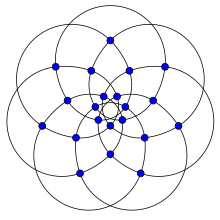Brinkmann graph
| Brinkmann graph | |
|---|---|

The Brinkmann graph
|
|
| Named after | Gunnar Brinkmann |
| Vertices | 21 |
| Edges | 42 |
| Radius | 3 |
| Diameter | 3 |
| Girth | 5 |
| Automorphisms | 14 (D7) |
| Chromatic number | 4 |
| Chromatic index | 5 |
| Properties |
Eulerian Hamiltonian |
In the mathematical field of graph theory, the Brinkmann graph is a 4-regular graph with 21 vertices and 42 edges discovered by Gunnar Brinkmann in 1992. It was first published by Brinkmann and Meringer in 1997.
It has chromatic number 4, chromatic index 5, radius 3, diameter 3 and girth 5. It is also a 3-vertex-connected graph and a 3-edge-connected graph. It is the smallest 4-regular graph of girth 5 with chromatic number 4.
By Brooks’ theorem, every k-regular graph (except for odd cycles and cliques) has chromatic number at most k. It was also known since 1959 that, for every k and l there exist k-chromatic graphs with girth l. In connection with these two results and several examples including the Chvátal graph, Branko Grünbaum conjectured in 1970 that for every k and l there exist k-chromatic k-regular graphs with girth l. The Chvátal graph solves the case k = l = 4 of this conjecture and the Brinkmann graph solves the case k = 4, l = 5. Grünbaum's conjecture was disproved for sufficiently large k by Johannsen, who showed that the chromatic number of a triangle-free graph is O(Δ/log Δ) where Δ is the maximum vertex degree and the O introduces big O notation. However, despite this disproof, it remains of interest to find examples and only very few are known.
The chromatic polynomial of the Brinkmann graph is x21 - 42x20 + 861x19 - 11480x18 + 111881x17 - 848708x16 + 5207711x15 - 26500254x14 + 113675219x13 - 415278052x12 + 1299042255x11 - 3483798283x10 + 7987607279x9 - 15547364853x8 + 25384350310x7 - 34133692383x6 + 36783818141x5 - 30480167403x4 + 18168142566x3 - 6896700738x2 + 1242405972x (sequence in the OEIS).
...
Wikipedia
